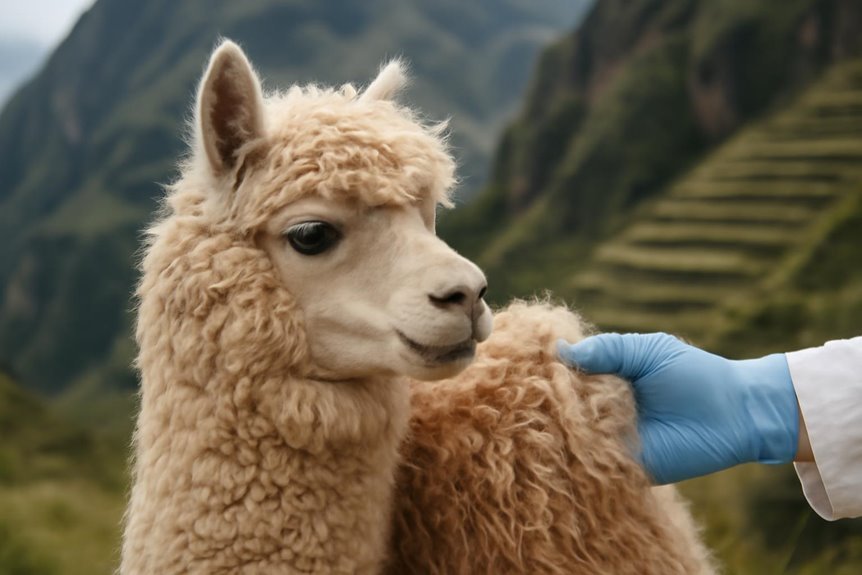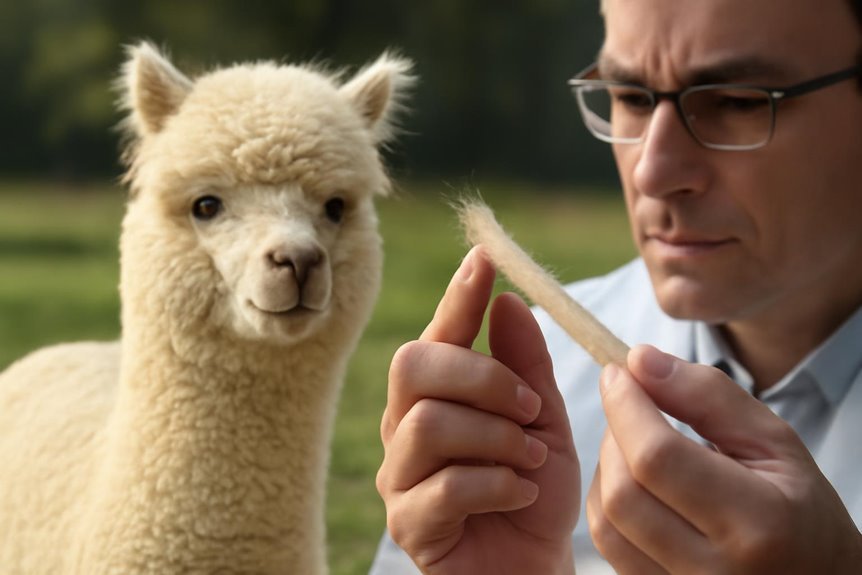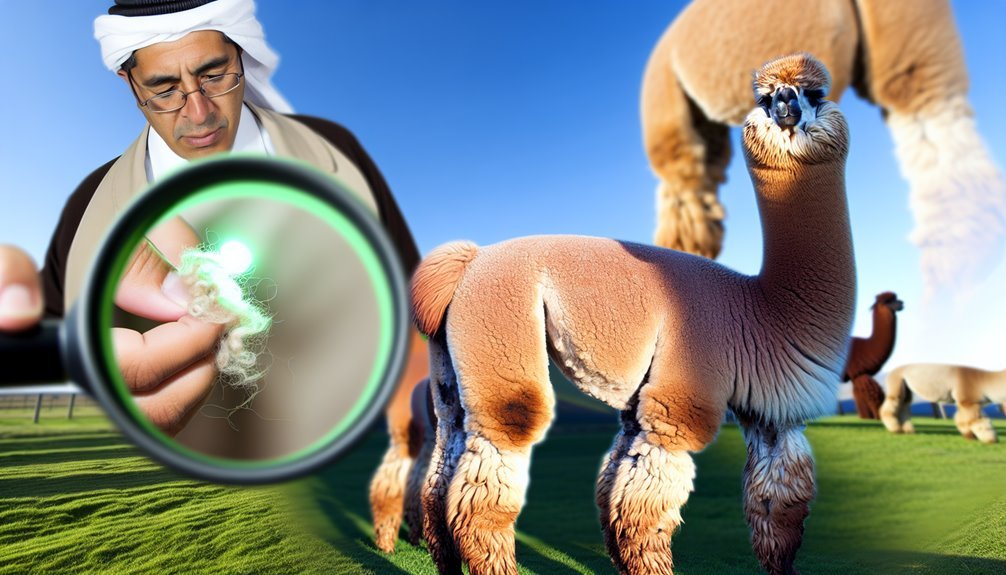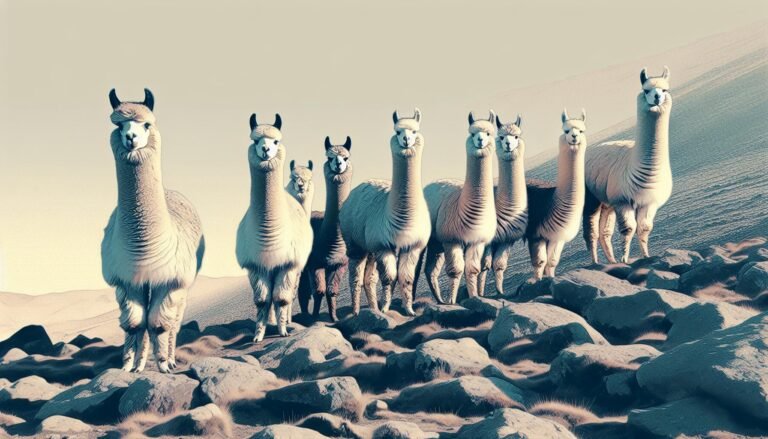Genetics’ Role in Determining Alpaca Fleece Quality
You’ll find that genetics plays a huge role in alpaca fleece quality, influencing traits like fiber diameter, weight, and uniformity. Key genes, such as ASIP and MC1R, control coat color and impact fleece characteristics, while others like TRPV3 affect fleece type. Since fleece quality traits show moderate heritability, selective breeding using genetic markers can greatly improve fiber. Exploring these genetic factors closely can reveal how modern molecular tools are transforming alpaca breeding for superior fleece production.
Key Takeaways
- Coat color and fleece traits in alpacas are influenced by genes like ASIP, MC1R, and TRPV3, affecting pigmentation and fiber type.
- Genetic selection with about 30% heritability for fleece quality traits enables significant improvements in fiber diameter, density, and uniformity.
- Maintaining genetic diversity enhances fleece quality by increasing the chances of producing finer, more uniform alpaca fiber.
- Molecular breeding uses genome sequencing and genetic markers to accelerate and refine selection for superior fleece traits.
- Genetic marker-based selection supports efficient breeding decisions, improving fleece weight and quality sustainably and systematically.
Origin and Domestication of Alpacas

Although alpacas have been domesticated for over 5,000 years in the Peruvian Andes, you might not know that their fine, dense fleece was highly prized by the Inca civilization. Derived from wild vicuñas, alpacas were selectively bred for desirable fleece traits such as fineness and softness. This domestic South American species’ alpaca fiber became a valuable resource due to careful genetic selection aimed at improving production quality. However, Spanish influence disrupted this process, causing a decline in fleece quality through unorganized breeding. Today, restoring superior fleece relies heavily on controlled mating and genetic selection strategies to enhance key traits like fiber diameter and crimp. By understanding the genes behind these traits, breeders can effectively improve alpaca fiber production, ensuring the fleece remains economically valuable and true to its ancient heritage.
Genetic Basis of Coat Color Variation
Just as selective breeding has shaped the quality of alpaca fleece over centuries, it’s also influenced the wide range of coat colors you see today. Coat color variation in alpacas results from complex genetic variants, especially involving the ASIP and MC1R genes that regulate pigmentation. Here’s what you should know:
- White is a dominant trait, but breeding two white alpacas doesn’t guarantee white offspring, due to recessive black alleles and multiple ASIP mutations.
- Mutations in ASIP and MC1R create diverse pigmentation patterns, contributing to the natural colors increasingly valued in the market.
- Understanding these genetic factors helps you predict color outcomes, influencing breeding choices and enhancing fleece characteristics linked to specific color phenotypes.
Embracing natural colors aligns with eco-friendly trends and adds market appeal beyond traditional white fleece.
Key Genes Influencing Fiber Traits
You’ll find that the ASIP gene plays a major role in fiber pigmentation, working closely with MC1R to determine color patterns in alpaca fleece. These genes don’t just affect color—they can also influence fiber structure and quality. Understanding their interactions helps you make smarter breeding decisions to improve fleece traits.
ASIP Gene Effects
When you look closely at alpaca fleece quality, the ASIP gene stands out as a key factor influencing both coat color and fiber traits. This gene’s genetic mechanisms regulate pigmentation, impacting the color phenotype and overall fleece quality. You’ll find that specific mutations within the ASIP gene play a big role in this:
- Certain ASIP variants increase white coloration dominance, which can improve fleece uniformity.
- Expression levels differ—white alpacas show higher ASIP activity, affecting fiber traits positively.
- Identifying these mutations helps you make informed breeding decisions aimed at enhancing color consistency and fiber quality.
MC1R and Pigmentation
Although several genes influence alpaca pigmentation, the MC1R gene plays a central role in determining fiber color by controlling the balance between eumelanin and pheomelanin production. In alpacas, variants of the MC1R gene directly affect coat color, with white being dominantly inherited and black a recessive trait. Understanding these MC1R genotypes helps you predict and select for specific pigmentation patterns, which is essential for improving fleece quality. By integrating knowledge of fiber genetics, you can make informed breeding decisions to enhance desirable coat colors. This genetic insight not only refines color traits but also supports broader genetic improvement efforts in alpacas, ultimately leading to better fiber characteristics and market value in your breeding program.
Fiber Structure Genes
Since fiber quality is crucial for alpaca fleece value, understanding the genes that influence fiber traits is essential for your breeding decisions. The TRPV3 gene plays a major role in determining fleece type, especially the Suri phenotype, which shows unique fiber characteristics like fewer cuticular scales. Inheritance patterns for fiber diameter and fiber density involve multiple genes, but high heritability allows effective selection within your alpaca population. To optimize fleece quality, focus on these key aspects:
- The TRPV3 gene impacts hair follicle development and fiber structure, influencing length and texture.
- Fleece type is mostly controlled by a dominant gene, distinguishing Suri from Huacaya alpacas.
- Selecting for fiber diameter and density traits helps improve overall fiber quality over generations.
Heritability and Selection for Fleece Quality

Because heritability for alpaca fleece quality traits is around 30%, you can expect a moderate genetic influence on characteristics like fiber diameter and uniformity. This means genetic selection plays a key role when choosing breeding animals to improve fleece quality. By focusing on production traits such as fleece weight and fiber diameter, you can achieve significant genetic gains. For example, selecting the top 5% of fleece cutters by weight can increase average fleece weight by 25%. Prioritizing single fleece traits during selection often yields better results than targeting multiple traits at once. Understanding heritability helps you set realistic expectations and design breeding programs that effectively enhance fleece production traits, ultimately improving the value and consistency of your alpacas’ fleece over generations.
Impact of Genetic Diversity on Fiber Production
When you maintain genetic diversity in your alpaca herd, you boost the chances of producing finer, more uniform fiber that stands out in the market. Genetic diversity directly impacts fleece quality by influencing key traits like fiber diameter, density, and uniformity. Since heritability of these traits is around 30%, selection based on diverse genetics can effectively enhance fiber production over generations. Here’s why it matters:
- Diverse genetics help correct undesirable traits, promoting finer fleece.
- Maintaining variety allows selection for superior traits, giving you a competitive edge.
- Focused selection on heavy fleece producers, combined with genetic diversity, can increase fleece weight by up to 25%.
Advances in Molecular Genetics for Breeding
You’re seeing how identifying key genes, like TRPV3 linked to fleece traits, is transforming alpaca breeding. Molecular tools now let you use genomic data to select for better fiber quality more precisely. This progress is shaping targeted breeding programs that improve fleece characteristics efficiently.
Gene Identification Progress
Although genetics can seem complex, recent advances have made it easier for you to understand how specific genes influence alpaca fleece quality. Significant gene identification progress has highlighted the TRPV3 gene’s role in the suri fleece phenotype, affecting hair growth due to a premature termination codon. You can now explore how single nucleotide variants (SNVs) and quantitative trait loci (QTL) relate to fleece characteristics, enabling more precise selective breeding. Key points include:
- Identification of over 39 million SNVs helps pinpoint genetic factors tied to fleece quality.
- The inheritance of fleece type is controlled by a single dominant gene, simplifying breeding strategies.
- QTL mapping provides essential insights for enhancing fiber traits through targeted selection.
These breakthroughs are transforming how you approach alpaca fleece improvement.
Molecular Breeding Applications
Since molecular genetics has advanced rapidly, you can now use genomic information to boost alpaca fleece quality more effectively. Molecular breeding leverages whole genome sequencing to uncover candidate genes and quantitative trait loci linked to key traits like fiber diameter and fleece uniformity. By identifying genes such as TRPV3, you can target specific variants that improve fleece characteristics in both suri and huacaya alpacas. This precise genetic mapping allows for more accurate selection, accelerating genetic gain in fiber production. Integrating these insights into breeding programs means you can implement genetic marker-based selection indices, making your breeding decisions more efficient and sustainable. Overall, molecular breeding transforms how you enhance fleece quality, offering a powerful tool to optimize alpaca fiber traits with greater speed and accuracy.
Frequently Asked Questions
What Is the Color Genetics in Alpacas?
You’ll find alpaca color inheritance complex, involving pigment genes like ASIP and MC1R. Genetic variants influence fleece color and phenotype expression, guiding breeding strategies for color classification, making outcomes less predictable but enhancing diversity.
What Makes a Good Alpaca?
You’ll want to focus on breeding techniques that improve fiber diameter and fleece density. Using genetic testing, assess lineage importance, conformation standards, and conduct thorough health assessments to guarantee your alpaca meets quality and productivity goals.
How Do You Know if an Alpaca Is Healthy?
You might think genetics alone determine health, but true health indicators include clear eyes, proper dietary needs, exercise requirements, regular veterinary care, social behavior, genetic testing, and fleece evaluation to guarantee your alpaca thrives holistically.
What Are the Characteristics of Alpaca Fleece?
You’ll notice alpaca fleece softness depends on fiber density and crimp definition, while staple length and fleece luster affect its feel. Color variation and fleece uniformity also play key roles in overall fleece quality.








Our picks
Alpaca & Wool Felted Sole Inserts: Comfy Upgrade?
Best Alpaca Socks for Hiking: Ultimate Comfort and Durability on Trails
Best Alpaca Halter for Comfort and Control